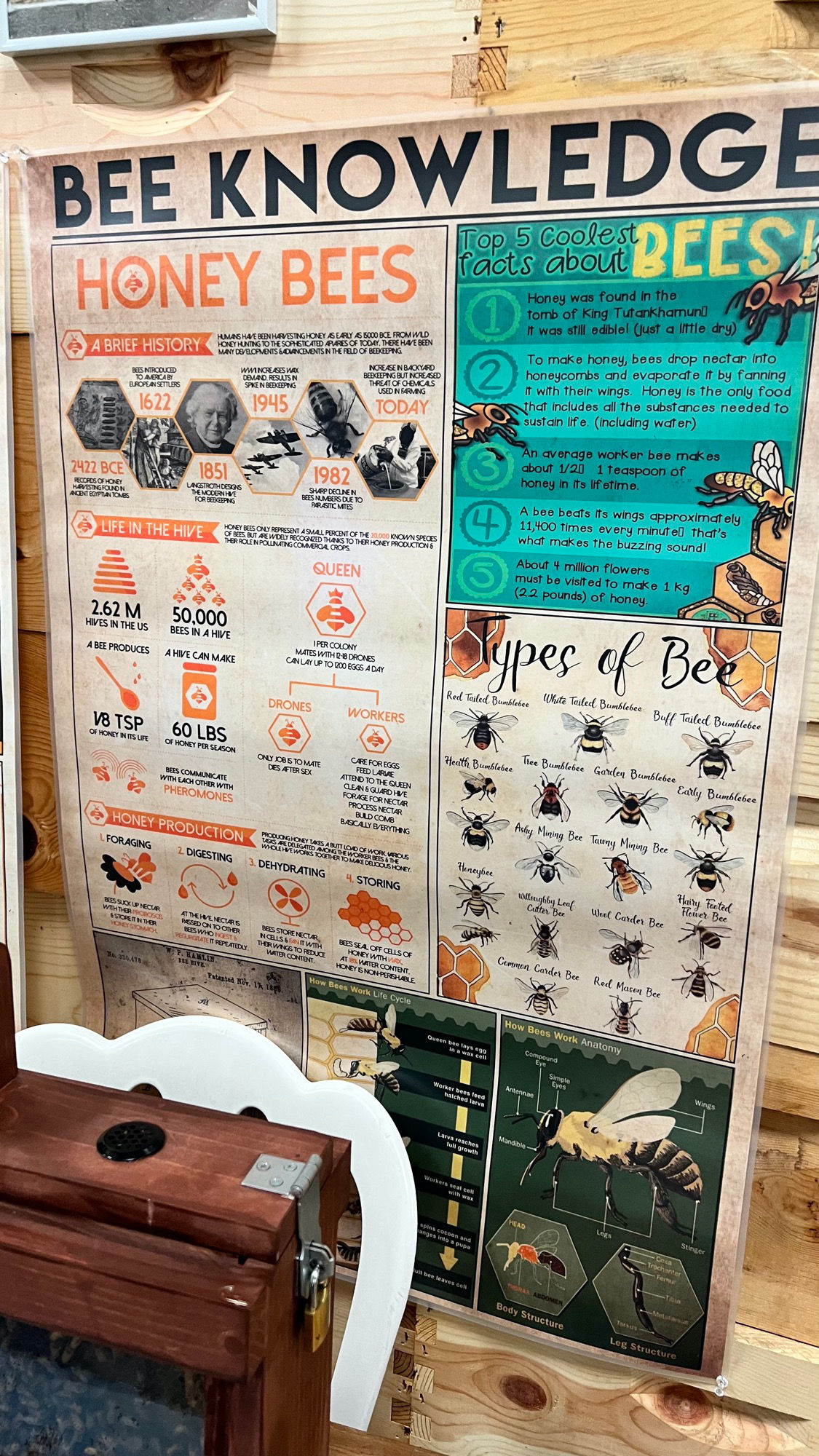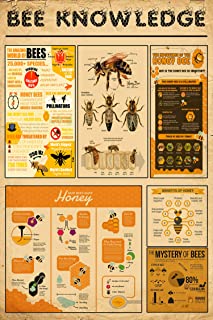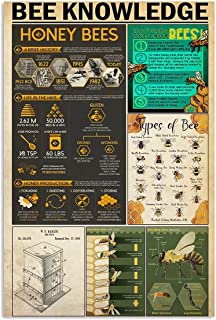
| HONEY BEES: | |
|---|---|
| A BRIEF HISTORY: Humans have been harvesting honey as early as 1500 BC from wild honey hunting to the sophisticated affairs of today. There have been many developments and advancements in the field of beekeeping. | |
| 2422 BCE | Records of honey harvesting found in ancient Egyptian Tombs |
| 1622 | Bees introduced to America by European Settlers |
| 1851 | Langstroth designs the modern hive for beekeeping |
| 1945 | WWI increases wax demand resulting in spike in beekeeping |
| 1982 | Sharp decline in bees numbers due to parasitic mites |
| TODAY | Increase in backyard beekeeping but increase in threat of chemicals used in farming | LIFE IN THE HIVE Honey Bees only represent a small percent of the 20,000 known species of bees but are widely recognized thanks to their honey production and their role in pollinating commercial crops |
| 2.26 M | Hives in the US |
| 50,000 | Bees in a Hive |
| 1/8 TSP | A bee produces 1/8 TSP of honey it its life |
| 60 LBS | A hive can make 60 LBS of honey per season |
| QUEEN | One per colony - Mates with 12-18 drones - Can lay up to 1200 eggs a day |
| DRONES | Only job is to mate - Dies after sex |
| WORKERS | Care for eggs - Feed Larvae - Attend to the Queen - Clean and guard hive - Forage for Nectar - Process Nectar | HONEY PRODUCTION Producing honey takes a lot of work. Various tasks are delegated among the worker bees and the whole hive works together to make delicious honey |
| FORAGING | Bees suck up nectar with their proboscides and store it in their honey stomach |
| DIGESTING | At the hive nectar is pass on to other bees who ingest and regurgitate it repeatedly |
| DEHYDRATING | Bees store nectar in cells and fan it with their wings to reduce water content |
| STORING | Bees seal off cells of honey with wax. At 18% water content honey is non-perishable |
| BEE KNOWLEDGE | |
Top 5 Coolest Facts about Bees
- Honey was found in the tomb of King Tutankhamun. It was still edible! (just a little dry)
- To make honey, bees drop nectar into honeycombs and evaporate it by fanning it with their wings. Honey is the only food that includes all the substances needed to sustain life. (including water)
- An average worker bee makes about 1/2 of 1 teaspoon of honey in its lifetime
- A bee beats it wings approximately 11,400 times every minute. That's what makes the buzzing sound!
- About 4 million flowers must be visited to make 2.2 pounds of honey
Types of Bee
- Red Tailed Bumblebee
- White Tailed Bumblebee
- Buff Tailed Bumblebee
- Heath Bumblebee
- Tree Bumblebee
- Garden Bumblebee
- Early Bumblebee
- Honeybee
- Ashy Mining Bee
- Tawny Mining Bee
- Hairy Footed Flower Bee
- Willughby Leaf Cutter Bee
- Wool Carder Bee
- Common Carder Bee
- Red Mason Bee
How Bees Work Lifecycle
- Queen Bee lays egg in wax cell
- Worker bees feed hatched larva
- Larva reaches full growth
- Workers seal cell with wax
- The Larve spins a cocoon and becomes a pupa
- Adult bee leaves it cell
How Bees Work Anatomy
- Mandible
- Antennae
- Compound Eye
- Simple Eyes
- Wings
- Stinger
- Legs

The Amazing World of Bees
- 25,000+ Species
- But only 5% are eusocial such as honey bees and bumblebees
EUSOCIAL: - Highly Organized Cooperative Group Dwellers
- Honey Bees Communicate about food by waggle-dancing
- Bees are important pollinators of crops, nuts, fibers, fruits, and vegetables including
- Brocolli
- Asparagus
- Apples
- Cherries
- One honey Bee Hive can contain 60,000 bees. But most species nest alone in hollow twigs, wood crevices, or underground burrows
- Bees are threatened by
- Loss of Habitats
- Toxic Pesticides
- Diseases
- Many Bee species are stingless
- Some Bees can flap their wings 250 times every second 250 HZ
- World's Biggest Bee: Megachile Pluto
- World's Smallest Bee: Trigona Duckei
Anatomy of the Head
- Simple Eyes (ocelli)
- Antennae
- Compound Eyes
- Tongue
- Mandibles
Honey Bees (apis mellifera)
- Antennae
- Compound Eye
- Ocelli
- Hamuli
- Forewing
- Hindwing
- Spiricle
- Spindle Hair
- Legs
- Mandibles
Honey Bee Types
- Worker
- Queen
- Drone
Life Cycle of Honey Bees
- Queen Lays Egg Worker feeds larva and seals cell Once larva reaches full growth
- Egg
- Day 6 Larva
- Day 10 Larva
- Day 15 Pupa
- Day 16 Pupa
- Day 21 Adult
How does a Honey Bee Pollinate Plants
- The honeybee is attracted to and seeks nectar from a flower
- The honeybee brushes against anthers and gathers nectar
- The pollen on the flower's anther gets stuck to the bee's fury body
- The bee successfully takes the pollen from the first flower and moves to a new flower
- As the bee collects nectar, some of the pollen from the original plant is rubbed onto the stigma of the new plant
- The pollen on the stigma of the flower grows a tube that travels to the ovule, and fertilization takes place
- The fertilized ovule develops into a seed that will soon be a beautiful flower
How Bees make Honey
- Collect Nectar
- Share it
- Nectar to Honey
- Fan the Honey
- Seal it
- Why they need to make honey
- Egg
- Larvae
- + Honey
- Pupa
- Bee
Benefits of Honey
- Blood Sugar Regulation
- Probiotic
- Beautiful and Healthy Skin
- Reduce Ulcers
- Soothes Coughs
- Heal Burns
- Boosts Memory
- Treats Wounds
- Provides Nutrients
- Anti-Bacterial
Bees fly 15 MPH

Honey Bee Anotomy Poster

Q: Did the Bees drink Buckwheat Nectar?
The Honey is rich in minerals
Q: Did the Bees visit the Avocado Flower?
The Honey has a rich molasses taste
Q: Did the Bees drink Sage Nectar?
The Honey is light, smooth, and versatile
Q: Did the Bees drink for the Orange Flower?
The Honey is sweet with a citrus zing!
Q: Did the Bees draw from the Tupelo Tree?
Honey is low glycemic and loaded with vitamins
Q: Did the Bees enjoy the Fireweek Flower?
The Honey will help ease a headache
Q: Did the Bees Pull nectar from Eucalyptus?
The Honey will ease a cold
Q: Did the Bees forage Sweet Clover?
The Honey will have natural notes of cinnamon
Wildflower Honey
If the beekeepers are not sure what flower the bees went to they name the honey wildflower. Wildflower honey usually helps with local allergies!

While we don't need bees to pollinate every crop, here Is just a brief list of some of the foods we would lose if all our bees continue to perish:
- Apples
- Kiwi Fruit
- Plums
- Peaches
- Nectarines
- Guava
- Rose Hips
- Pomegranates
- Pears
- Black and Red
- Currants
- Alfalfa
- Okra
- Strawberries
- Onions
- Cashews
- Prickly Pear Cactus
- Apricots
- Allspice
- Avocados
- Passion Fruit
- Lima Beans
- Kidney Beans
- Adzuki Beans
- Green Beans
- Custard Apples
- Cherries
- Celery
- Coffee
- Walnuts
- Cotton
- Lychee
- Flax
- Mangos
- Macadamia Nuts
- Sunflower Oil
- Goa Beans
- Lemons
- Buckwheat
- Fennel
- limes
- Quince
- Carrots
- Persimmons
- Loquats
- Durian
- Cucumber
- Hazelnut
- Cantaloupe
- Tangelos
- Coriander
- Caraway
- Chestnut,
- Watermelon
- Tangerines
- Boysenberries
- Starfruit
- Brazil Nuts
- Beets
- Mustard seed
- Broccoli
- Cauliflower
- Cabbage
- Brussels Sprouts
- Bok Choy
- Turnips
- Rambutan
- Chili peppers
- Bell peppers
- Papayas
- Safflower
- Sesame
- Eggplant
- Raspberries
- Elderberries
- Blackberries
- Clover
- Tamarind
- Black Eyed Peas
- Cranberries
- Tomatoes
- Grapes
- Almonds






